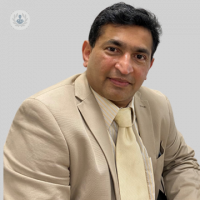Mole mapping: why is it important?
Escrito por:Mole mapping, also known as total body photography, is a comprehensive method used to monitor and track moles and other skin lesions over time. This technique is crucial for the early detection of skin cancer, particularly melanoma, which is the most serious type of skin cancer. Leading consultant dermatologist Dr Jibu Varghese delves into what mole mapping entails, who should consider it, and what you can expect during the process.

How does mole mapping work?
Mole mapping involves taking detailed photographs of the entire surface of your skin. These images serve as a baseline for future comparisons. By periodically updating these photographs, dermatologists can detect even subtle changes in existing moles or the appearance of new ones.
During a mole mapping session, you will be asked to stand in various positions while a specialised camera captures images of your skin from multiple angles. These high-resolution photographs are then analysed using advanced software that assists dermatologists in identifying potential areas of concern.
At the Melbury Skin Clinic, we incorporate the use of full body mole mapping with a technology called 4th Gen FotoFinder ATBM.
Who should consider mole mapping?
Mole mapping is especially recommended for individuals at higher risk of developing skin cancer. You may be considered at high risk if you have:
- A family history of melanoma or other skin cancers.
- Numerous moles or atypical (unusual-looking) moles.
- A history of severe sunburns, particularly in childhood.
- Fair skin, freckles, or red hair.
- A history of using tanning beds.
- Even if you do not fall into these categories, regular skin checks are an important preventive measure. Mole mapping provides a meticulous approach to monitoring your skin's health.
What are the benefits of mole mapping?
The primary benefit of mole mapping is the early detection of skin cancer. Melanoma, when identified at an early stage, can often be treated successfully. Regular mole mapping allows for the early identification of changes that might indicate the onset of skin cancer, providing an opportunity for prompt intervention.
Another benefit is peace of mind. Knowing that your skin is being carefully monitored by professionals can alleviate anxiety about skin cancer. It also helps to create a permanent and detailed record of your skin's condition, which is particularly useful for individuals with many moles.
What can you expect during a mole mapping session?
During a mole mapping session, you will be asked to undress to your underwear to allow the dermatologist to take comprehensive photographs of your skin. You may feel a little self-conscious, but rest assured that this is a routine procedure for the professionals involved. The session typically takes between 30 to 60 minutes.
The dermatologist will review the images and may use a dermatoscope, a special magnifying tool, to examine any moles that appear suspicious. If any moles look concerning, the dermatologist might suggest further examination or a biopsy, where a small sample of tissue is taken for analysis.
How often should you have mole mapping done?
The frequency of mole mapping can vary based on individual risk factors. For those at high risk, annual mole mapping is often recommended. However, your dermatologist will provide guidance based on your specific situation. Between mapping sessions, it's crucial to perform regular self-examinations and report any changes in your moles to your healthcare provider promptly.
In conclusion, mole mapping is a valuable tool in the fight against skin cancer, offering early detection and peace of mind. If you have concerns about your moles or skin health, consult with your dermatologist to see if mole mapping is right for you.
If you would like to book a consultation with Dr Jibu Varghese, simply visit his Top Doctors profile today.


